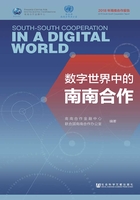
1.9 报告大纲
在全球经济向数字化转型的过程中,发展中国家,尤其是极不发达国家不应就此掉队。因此,数字经济在当下和将来会对可持续发展目标产生什么影响?经济发展是实现《2030年可持续发展议程》的一大基石,发展中国家蓬勃发展的技术部门,特别是从事平台经济和数字贸易的中小型企业,可以极大地促进经济发展。事实上,只要他们的举措获得一定的临界质量,包括智能合约和区块链在内的服务数字化同样为贫困人口提供了更好地进入和参与全球(数字)经济的机会。
数字经济正在改变人类生活和企业运营的方式,但在南方国家发展中国家的语境下,则需要做出更多的努力来发挥其优势和应对其挑战。在南南合作中,必须做更多的工作来概念化具体的进程和机制,以支持发展中国家的可持续发展。后续章节概述了如下内容:平台经济、数字贸易、智能合约、数字金融和智慧社会。
在本章(第1章)的介绍之后,第2章将聚焦平台经济,特别是数字和智能技术的南南合作,如大数据、人工智能、机器人、物联网和区块链。南方国家的大多数国家在数字化上都不活跃,但一些新兴经济体在数字技术方面处于领先地位,因此可以推动南南合作,使发展中国家能够从传统经济向平台经济转型,并分享全球数字红利。发展底层数字经济基础设施是重点所在,如互联网服务器和服务、移动电话和移动互联网、移动支付等相关的电子商务服务,以及工业园区和经济特区的线上线下综合发展。这一章强调了在南南合作框架内进行技术转让的重要性。
第3章介绍数字贸易,分析发展中国家的跨境电子商务,特别是使用数字交易技术的商品和服务贸易。通过降低交易成本,数字贸易为中小型企业创造了新的、更大的机遇,从而使南方国家的国家能够深化技术和投资合作。通过权衡机遇和挑战,显然在这一领域还有很多工作要做,但是在快速加速期间多方面了解南方的语境将有助于形成一个明确的工作计划概念。
第4章介绍了智能合约,描述了基于区块链的贸易便利化和智能监督解决方案。试点项目和实际部署的证据展示了如何发布此类解决方案以解决南方国家面临的挑战,例如,跟踪不同参与者之间的附加值以确保整个价值链的合理工资,以及需要具备诸如身份证件和银行账户等先决条件才能参与全球贸易。相关案例——如跟踪出口的咖啡以证明向农民支付了生活所需工资,以及创建一个基于生物识别数据(如面部和语音识别算法)建立用户档案的应用——展示了引入南北贸易中的数字技术如何在不久的将来促进南南贸易。
在关于“数字金融”的第5章中详细介绍了金融技术在南南合作中的作用和趋势。具体而言,这一章审视了为促进普惠金融引入数字金融所带来的机遇,数字金融对无银行账户的人群、企业、金融服务提供商和政府均产生了不同的影响。通过聚焦无法获得信贷的中小型企业案例,反映出在发展中国家可以释放出额外的经济增长能量。由于融资是实现可持续发展目标的一个主要问题,效率是未来的一个广泛主题,若将现代技术与现代金融联系起来,可加深对南方国家未来可能性的理解。
第6章介绍了以人为本的智慧社会。对许多发展中国家具有启示意义的是,智慧社会的发展过程划分为三个阶段:人脸识别、移动支付等专项技术的发明创造提供了突破性支撑;同类技术组合、集成应用于某一领域,推动了该领域的智能化;把智慧交通、智慧教育和健康服务、智能灾害应急服务,以及智慧政务等社会服务和社会治理综合应用,就逐步形成了智慧社区、智慧城市,乃至智慧社会。显而易见,数字技术推动了社会向智慧社会的智能转型过程。
第7章着重介绍互联网连通性如何影响价值链和网络,特别是通过肯尼亚的案例研究介绍东非的业务流程外包。这一章审视互联网能否促进以及如何促进“业务流程外包”这个行业的发展,该行业有赖于通过信息通信技术跨越低收入和高收入国家间的地理距离。之所以选择肯尼亚的业务流程外包部门进行案例研究,是因为2009年该地区的第一条光缆到达了肯尼亚沿海。互联网基础设施的大规模升级提供了难得的机会,人们可以凭借经验审视信息通信技术对经济发展的短期和中期影响,并将愿景和希望与过去五年实现的事实结果进行比较。这一章拓宽了对连通性的理解,而不仅仅局限于纯粹靠技术支持访问的互联网连通性。通过检查参与者的社会和概念连通性的变化,以及与互联网连通性互补的促成因素,审视了东非新技术基础设施的更深远影响。
最后,第8章提供了本报告的综述,并提出了通过南南合作促进数字化转型的方向。人口稠密且发展较快的发展中国家需要与发达国家一道,支持其他发展中国家和低收入国家,而南南合作可以成为促使数字经济实现可持续发展目标的催化剂。为了实现不让任何一个人掉队的承诺,国家、地区和全球层面都必须出台侧重于数字化的针对性政策。在国家层面的南南合作中,应优先考虑数字产业政策、数据监管政策、电子商务平台和促进数字金融的金融基础设施。在地区层面,可以根据贸发会议的十条南南数字合作议程制定举措,区域一体化议程有助于培养智慧社会,而区域开发银行可以通过包括建立数字发展基金在内的方式,以数字方式帮助成员。南北技术转让仍然很重要,国际合作,特别是通过可持续发展目标基金开展的国际合作,对于联系数字技术和服务,帮助各国推进实现可持续发展目标具有不可或缺的作用。本报告非常有意义,考虑到隐含的指数级变化,若能善加把握时机,可以带来相当有利的结果。
参考文献
Adhikari,R. and Lekey,D. (2017). “Digital Can Lift the Developing World out of Poverty. Here’s How.” World Economic Forum,https://www.weforum. org/agenda/2017/07/digital-least-developed-countries inequality/,10 July 2017.
Arbache,J. (2018). “Seizing the Benefits of the Digital Economy for Development | International Centre for Trade and Sustainable Development.” International Centre for Trade And Sustainable Development. https://www.ictsd.org/opinion/seizing-thebenefits-of the-digital-economy-for-development.
AT Kearney (2015). “The 2015 A.T. Kearney Foreign Direct Investment Confidence Index.” https://www.atkearney.com/documents/20152/435992/Connected+Risks-Investing+in+a+Divergent+World-FDICI+2015.pdf/da59de3e-6209b553-936e-51dbdec43aa8.
Banga,R. and Richard,K.W. (2018). “South-South Digital Cooperation for Industrialization:A Regional Integration Agenda.” UNCTAD/GDS/ECIDC/2018/1,United Nations Conference on Trade and Development.
Barefoot,K. et al. (2018). “Defining and Measuring the Digital Economy.” Working Paper,Bureau of Economic Analysis-U.S. Department of Commerce,15 Mar.2018,p.24.
Bhattacharya,D. (2016). “Regional Monitoring and Review Mechanism for Effective Implementation of the Post-2015 Development Agenda.” Southern Voice Occasional Paper 28,Southern Voice on Post-MDG International Development Goals. http://southernvoice. org/wp-content/uploads/2016/02/SV-OP-28.pdf.
Bhattacharya,D. (2018). “SDG Financing in the Developing Countries:Like Clouds and Wind without Rain.” Southern Voice Occasional Paper 50,Southern Voice on Post-MDG International Development Goals. http://southernvoice.org/wp-content/uploads/2018/10/SVOP50.pdf.
Cann,O. (2015). “Revealed:The Digital Poverty Holding Back Global Growth and Development.” World Economic Forum,2015,https://www.weforum. org/press/2015/04/revealed-the-digitalpoverty-holding-back-global-growth-anddevelopment/.
Carmody,P. (2012). “A Knowledge Economy or an Information Society in Africa?Thintegration and the Mobile Phone Revolution.” Information Technology for Development,Vol.19,No.1,pp.24-39.
Chakravorti,B. (2017). “There’s a Gender Gap in Internet Usage. Closing It Would Open Up Opportunities for Everyone.” Harvard Business Review,https://hbr.org/2017/12/theres-a-gender-gap-in-internet-usage-closing-it-would-openup opportunities-for-everyone,12 December.
Chakravorti,B. (2018). “Technology May Seek to Flatten The World,But The ‘Digital South’ Will Chart Its Own Course.” The Forum Network,Hosted by the OECD,https://www.oecd-forum.org/users/79580-bhaskar-chakravorti/posts/36382-technologymay seek-to-flatten-the-world-but-the-digital-south-will-chart-its-own-course,12 July.
Chakravorti,B. et. al. (2017). Digital Planet 2017:How Competitiveness and Trust in Digital Economies Vary Across the World. The Fletcher School,Tufts University.
Clark,H. (2013). “ICT as a Powerful Means to Advance Women’s Rights,Empowerment and Gender Equality.” UNWomen,http://www.unwomen. org/en/news/stories/2013/9/ed-speech-to-broadband-gender-group,20 September.
Espinel,V. (2016). “The Digital Economy:What Is It and How Will It Transform Our Lives?” World Economic Forum,https://www.weforum.org/agenda/2016/11/thedigital-economy-what-is-it-and-how-will-it-transform-our-lives/.
Finance Center for South-South Cooperation (FCSSC) (2017). Changing Roles of South-South Cooperation in Global Development System:Towards 2030. 2017 South-South Cooperation Report,Finance Center for South-South Cooperation,2017.
Foster,C. et. al.(2017)“Digital Control in Value Chains:Challenges of Connectivity for East African Firms.” Economic Geography,Vol.94,No.1,pp.68-86.
Foster,C. and Graham,M. (2015a). Connectivity and the Tea Sector in Rwanda. Oxford Internet Institute Report,Oxford Internet Institute.
Foster,C. and Graham,M. (2015b). The Internet and Tourism in Rwanda. Oxford Internet Institute Report,Oxford Internet Institute.
Friederici,N. (2017). “The Impact of Connectivity in Africa:Grand Visions and the Mirage of Inclusive Digital Development.” Electronic Journal of Information Systems in Developing Countries,Vol.79,No.2,pp.1-20. https://onlinelibrary.wiley.com/doi/pdf/10.1002/j.1681-4835.2017.tb00578.x.
Graham,M. (2018). “Uneven Digital Geographies… and Why They Matter.” In Kollektiv Orangotango (ed.),This is Not an Atlas,Transcript-Verlag,pp.310-318.
Graham,M. (2017). “Digital Labour and Development:Impacts of Global Digital Labour Platforms and the Gig Economy on Worker Livelihoods.” Transfer:European Review of Labour and Research,Vol.23,No.2,pp.135-162.
Graham,M. and Woodcock,J. (2018). “Towards a Fairer Platform Economy:Introducing the Fairwork Foundation.” Alternate Routes,Vol.29,pp.242-253.
Hamann,R. (2018). “Developing Countries Need to Act on the Risks Posed by New Technologies.” World Economic Forum. https://www.weforum.org/agenda/2018/01/developing-countriesneed-to-act-on-the-risks-posed-by-newtechnologies/.
Hilbert,M. (2011). “Digital Gender Divide or Technologically Empowered Women in Developing Countries?A Typical Case of Lies,Damned Lies,and Statistics.” Women’s Studies International Forum,Vol.34,No.6,pp.479-489.
Huawei Technologies Co. (2018). “Tapping into New Growth with Intelligent Connectivity.” Global Connectivity Index.
ICT Policy Section (2018). The “New” Digital Economy and Development. Technical Note,TN/UNCTAD/ICT4D/08,United Nations Conference on Trade and Development.
ITU (International Telecommunications Union) (2017a). Measuring the Information Society Report:Vol.1,International Telecommunications Union.
ITU (International Telecommunications Union) (2017b). Measuring the Information Society Report:Vol.2,ICT Country Profiles. International Telecommunications Union.
Jamann,W. (2017). “Women Must Be at the Heart of the Digital Revolution.” World Economic Forum,https://www.weforum.org/agenda/2017/05/women-must-be-at-the-heart-of-the-digital-revolution/,9 May.
Kituyi,M. (2018). “The ‘Fourth Industrial Revolution’ Can Power Sustainable Development,If We Get It Right.” News-UNCTAD,https://unctad.org/en/pages/newsdetails.aspx?OriginalVersionID=1746,8 May.
Klapper,L. and Jake H. (2016). “5 Ways Digital Finance Can Help People Escape Poverty.” World Economic Forum,https://www.weforum.org/agenda/2016/12/five-ways-to-help-more-people-benefit-from-digital-finance/,16 December.
Mann,L. et. al. (2015). The Internet and Business Process Outsourcing in East Africa. Oxford Internet Institute Report,Oxford Internet Institute.
Mehta,A. et. al. (2018). “How to Build Inclusive Digital Economies.” Development Matters,https://oecd-development-matters.org/2018/03/01/how-to-buildinclusive-digital-economies/,1 March.
Mei Chang,A. (2015). “How The Digital Economy Can Help End Extreme Poverty.” TechCrunch,http://social.techcrunch.com/2015/08/22/how-the-digitaleconomy-can-help-end-extreme poverty/.
Mohieldin,M. (2018). “Leveraging Technology to Achieve the Sustainable Development Goals.” Voices,https://blogs.worldbank.org/voices/leveraging technology-achieve-sustainable-development-goals,10 May.
OECD (Organisation for Economic Co-operation and Development). (2018). Empowering Women in the Digital Age-Where Do We Stand?Organisation for Economic Co-operation and Development,14 Mar.
OECD (Organisation for Economic Co-operation and Development). (2017). OECD Digital Economy Outlook 2017. OECD Publishing.
Ojanpera,S. (2018). “Mapping Broadband Affordability in 2016.” Geonet,Oxford Internet Institute,https://geonet.oii.ox.ac.uk/blog/mapping-broadbandaffordability in 2016,30 October.
Ozili,P. (2018). “Impact of Digital Finance on Financial Inclusion and Stability.” Borsa Istanbul Review 2018,https://www.sciencedirect.com/science/article/pii/S2214845017301503.
Reinsdorf,M and Gabriel Q. (2018). Measuring the Digital Economy. Staff Report,International Monetary Fund,28 February.
Richtel,Matt (2010). “Attached to Technology and Paying a Price.” The New York Times,https://www.nytimes.com/2010/06/07/technology/07brain.html,6 June.
Runciman,D. (2016). “Politics Has Gone Wrong. Is Digital Technology to Blame?” The Guardian,https://www.theguardian.com/commentisfree/2016/oct/31/politics-digital-technology-brexit-donald-trump,31 October.
Schwab,K. (2016). The Fourth Industrial Revolution. Crown Publishing Group.
Schwab,K. (2018). “The Urgency of Shaping the Fourth Industrial Revolution.” World Economic Forum,https://www.weforum.org/agenda/2018/01/theurgency-of-shaping-the-fourth-industrial-revolution/.
Strochlic,N. (2018). “The Race to Save the World’s Disappearing Languages.” National Geographic News,https://news.nationalgeographic.com/2018/04/saving-dying-disappearing-languages-wikitongues-culture/,16 April.
Tapscott,D. (1996). The Digital Economy:Promise and Peril in the Age of Networked Intelligence. McGraw-Hill.
UN (United Nations)(2017). State of South-South cooperation;Report of the Secretary-General. A/72/297,United Nations,7 August.
UN (United Nations)(2018a). “Role of South-South Cooperation and the Implementation of the 2030 Agenda for Sustainable Development:Challenges and Opportunities.” Report of the Secretary-General. A/73/383,United Nations,17 September.
UN (United Nations)(2018b). “State of South-South Cooperation.” Report of the Secretary General. A/73/321,United Nations,13 August.
UNDP (United Nations Development Programme)(2009). “Overcoming Barriers:Human Mobility and Development.” Human Development Report 2009,United Nations Development Programme.
UNOSSC (United Nations Office for South-South Cooperation)(2016). Good Practices in South-South and Triangular Cooperation for Sustainable Development. United Nations Office for South-South Cooperation,May.
UNOSSC (United Nations Office for South-South Cooperation)(2018). Good Practices in South-South and Triangular Cooperation for Sustainable Development-Volume 2. United Nations Office for South-South Cooperation,September.
Varian,H. (2016). “Intelligent Technology.” Finance & Development,Vol.53,No.3,pp.6-9.
Wladawsky-Berger,I. (2015). “Will the Digital Revolution Deliver for the World’s Poor?” Brookings Institution.
[1] Hany Besada,博士,联合国南南合作办公室高级研究协调员。
[2] 本报告将“南方国家”视作一个社会经济和分散的地理概念,泛指“人类发展指数”得分低于0.9的全体发展中国家。人类发展指数衡量人类发展的三个维度,即长寿和健康的生活、知识的获取,以及体面的生活水准,发达国家的这一得分为0.9或以上(见UNDP,2009)。
[3] 本章中使用“数字技术”这个笼统的术语,涵盖了从数字化信息或计算机驱动进程中派生功能的所有新技术。在此分类中,我们包含了信息通信技术。
[4] 在爱沙尼亚名为e-Estonia的数字化项目中,所有规范化的公共服务都通过一个单一可访问平台实现数字化并提供链接。
[5] 有人按工业时代或工业革命划分了当代的人类历史。第一次工业革命伴随着工厂生产的崛起,促使人类的经济生活从农村转向城市。第二次工业革命是现有工业的增长期。第三次工业革命是数字技术的发展和崛起。Schwab(2018)提出的第四次工业革命是将这些先进技术融入社会的各个方面。
[6] 根据笔者的观点,“数字演化指数共使用108个指标来衡量一个国家的数字化状态和质量。该指数分为四个层级:指标、集群、成分和驱动因素。指标是回答特定问题的数据点。集群是指标的统计学分组,这些指标经过标准化、刻度化和加权,为分析和比较生成标准化值;集群结合并捕获来自多个指标的信息,以阐明影响数字化的特定方面……集群在组合后形成成分,而成分则是驱动因素的基本构件。成分的构建是为了全面理解形成和定义驱动因素的因素”(Chakravorti et al.,2017)。
[7] 了解具体的国情简介、国家指标、与各个地区和全球的比较,以及关于移动服务、固话服务和政府政策的详细信息,请参见ITU(2017a,2017b)。
[8] 参见联合国《可持续发展目标》,https://sustainabledevelopment.un.org。
[9] 智能手机是能够通过无线信号访问和使用互联网的设备。移动电话通常只有语音和收发短信的功能,无法上网。